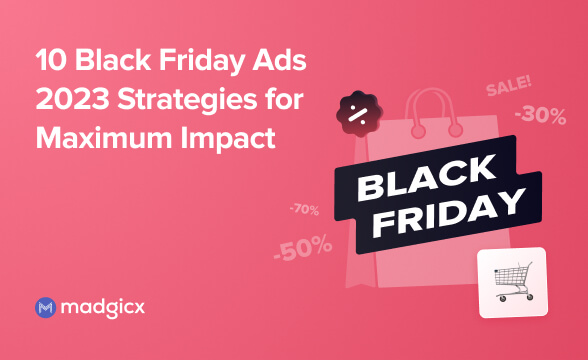It's tough to find the right marketing analytics tool for your business. Let's break down the top tools you need to analyze your marketing channels today.
All the corporate layoffs and budget cuts we saw in 2022 seem to be continuing throughout 2023—but some of the software solutions you cut from your tech stack could prove to be a fatal move in the future.
The most important of which, in my opinion, is your marketing analytics tools.
In this article, we'll cover what marketing analytics tools are, why they're so important to have, and the top 6 leading tools on the market in 2024.
What is a marketing analytics tool?
Marketing analytics tools are a special niche of software that helps businesses measure, analyze, and optimize their marketing efforts. These tools can be used to track a wide range of things, including website traffic, paid and organic social media metrics, CRM data, and even data from your eCommerce store in some cases.
The term itself is pretty straightforward—these are tools that help you to analyze your marketing campaigns. However, like all things, 'the devil is in the details'.
The exact type of data each tool tracks is completely different from company to company as they all specialize in different areas of marketing analytics. There are a few general categories of tools that should be familiar to you already.
Web analytics tools
One common type of marketing analytics tool is web analytics software, which tracks website traffic and behavior. These tools typically track metrics such as page views, bounce rates, and page conversion rates. The most popular one by far is Google Analytics.
These tools can also be used to segment website visitors by location, device, and referral source. This information can be used to optimize the website for better performance and to find where users may be falling through your marketing funnel.
Email marketing analytics tools
Another type of marketing analytics tool is email marketing analytics, usually taken from your CRM, or a customer relationship management tool. These tools can be used to track metrics such as open rates, click-through rates, and conversion rates for email campaigns.
They can also be used to segment email subscribers and track user behavior or demographics of individual recipients. Some popular ones are HubSpot, MailChimp, and ActiveCampaign.
Organic and paid social media analytics tools
Organic social media analytics tools are another commonly used type of marketing analytics tool. These tools can be used to track metrics such as engagement, reach, and conversion rates for social media campaigns.
On the other side, there are also paid media analytics tools. These tools track the data of your paid channels (like Facebook ads, LinkedIn ads, and Google ads to name a few). These tools are mostly focused on optimizing social media campaigns for better performance and identifying areas where the campaigns may be underperforming.
Now, as you can imagine, having all of these types of tools with their own rules, features, and reporting methods can be expensive and migraine-inducing, to say the least. That's why, for this post, we're going to focus on tools that combine data from the categories above into one ultimate source of truth.
Why you must use a marketing analytics tool in 2024
You might first be asking yourself why you'd need a marketing analytics tool if each individual platform already has its own set of metrics and reports. Which, given the budget cuts we mentioned earlier, seems a fair question.
However, there are a few key reasons why you want to add an all-in-one marketing analytics software to your tech stack.
The first (and most important, in my opinion) is the time saved by combining all these different data sets into one place. Creating a report for one channel is time-consuming enough, as I'm sure you know. In fact, marketers spend an average of 3.5 hours a week collecting, organizing, and analyzing data alone.

On top of that, it's more likely than not that you're managing more than one channel at a time. By using an all-encompassing analytics tool, you can easily generate a report from each channel in half the time you spend creating them all individually.
Marketing analytics tools also provide businesses with the ability to compare the effectiveness of different channels and tactics. For example, if a business is using multiple channels such as email, social media, and paid search to reach its audience, it can use marketing analytics tools to see which channels are driving the most conversions.
Additionally, all-in-one marketing analytics tools can help businesses identify patterns and trends in customer behavior that you might miss by only looking at one channel at a time. These tools can provide insights into customer behavior such as purchase history, website interactions, and all the different paths customers take to convert.
You can then use your newly unified marketing data to identify patterns in customer behavior and optimize your marketing strategies to capitalize on these patterns and improve where you see gaps in performance.
Lastly, one of the best perks of a marketing analytics tool is that it unifies your marketing data into a single source of truth. All too often I see companies that are working with incredibly siloed data sets. For example, the marketing teams that are responsible for paid and organic social reporting work completely independently from each other and even use completely different tools to do so.
By unifying the data from your marketing channels into one place, each member of the team will be able to have oversight into the work of others and know how their role is playing into the company's overall goals.
With the right tools, you can even save money by going with a single, robust option instead of multiple subscriptions for each marketing channel you have.
If we've learned anything in 2022, it's that saving money and increasing your marketing ROI is the best way to go.
The top 6 marketing analytics tools in 2024
Finding the right marketing analytics tools can be compared to finding a needle in a haystack. The truth is that each platform has its pros and cons, and every business will have one that suits them more than others.
Before you read any further, it's important to take a step back and think about the data you need to have, and how you would ideally interact with this data (dashboards vs. pdf reports, internal or external use, etc.).
By looking at these two things, you'll be able to find a tool that does what you need as well as one that saves you time and money in the long run.
Without further ado, let's dive in!
1.One-Click Report by Madgicx
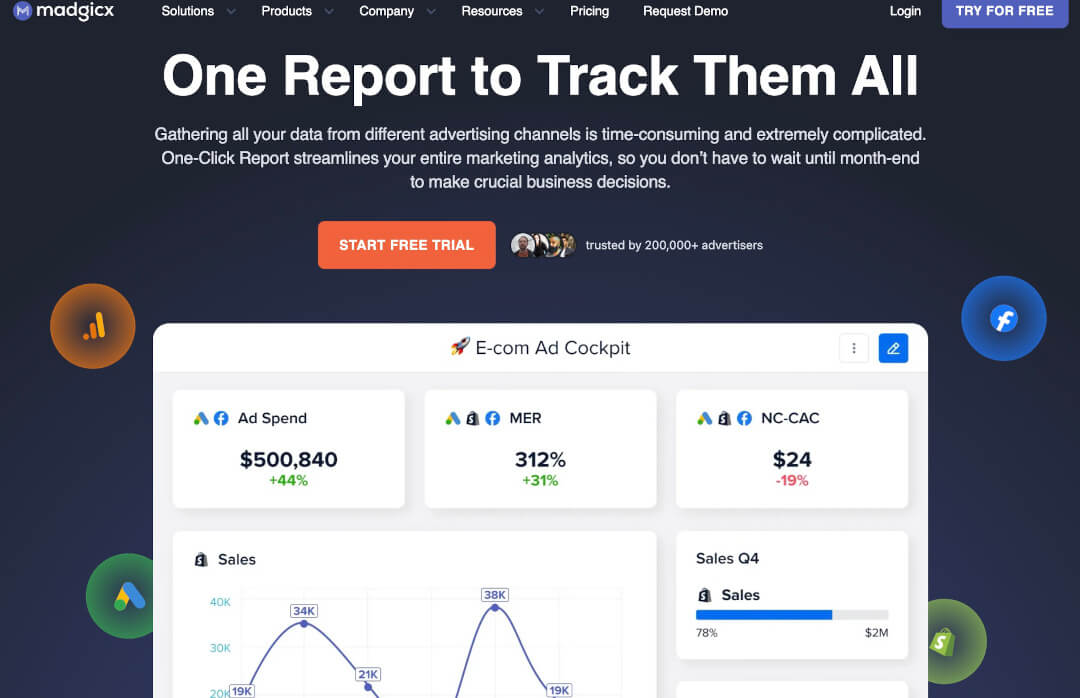
The reason we're so knowledgeable about marketing tools is that we have one of the best on the block. ;)
First up on our list is the One-Click Report tool by yours truly. The One-Click Report was designed to help analyze and optimize your Meta ads, Google ads, TikTok ads, Shopify store, and website analytics data by creating a one-stop shop for paid media data analysis.
One-Click Report aggregates your live data into one place so you can easily optimize your marketing campaign performance in these channels the moment you see them start to dip—something that traditionally happens once a month after a significant amount of financial damage has been done.
On top of that, the One-Click Report tool truly lives up to its name with its host of 11 pre-made templates that cover every combination of Facebook, Instagram, Google Ads, Google Analytics 4, TikTok, and Shopify analytics you could ever need.
You can share these reports internally and even externally with people (like clients) who do not have access to your Madgicx account. These templates are also fully customizable using a simple drag-and-drop report builder, and if that wasn’t customized enough, you can also create them from scratch.

The best part about this has to be the price point—you can get all of these options starting at just $29/month for 5 reports! There’s also a 7-day free trial available (with no credit card required) so you can test drive them all today at no risk or cost.
It's also important to note that the One-Click Report is also just one of the many tools Madgicx has to offer.
If you’re worried about tracking and attribution problems (which, in this day and age, you should be) Madgicx can also get a reliable tracking system set up for you in as little as 2 days with the Madgicx Could Tracking service. This handy service will help you capture at least 20% more data in your reports, allowing you to maximize the data you have available and preventing you from making inaccurate decisions based on bad data.
For those who are in need of some help with managing their day-to-day workload, Madgicx’s suite of automated tools like Autonomous Budget Optimizer, Automation Tactics, and Custom Automation has your back. This suite of tools can help you with things like managing your budget to increase the ad spend of high-performing ads and kill the others and create personalized account-based triggers to automate even the most complex of tasks.
You can also deploy multiple audiences, use AI to help fine-tune your ad copy, and even get an on-demand design team to help with your ad creatives all with the Madgicx suite of products at an additional cost.
It’s safe to say with Madgicx, you not only get all the data you need, but a tool that will help you optimize it all by itself. ;)
2. Google Analytics
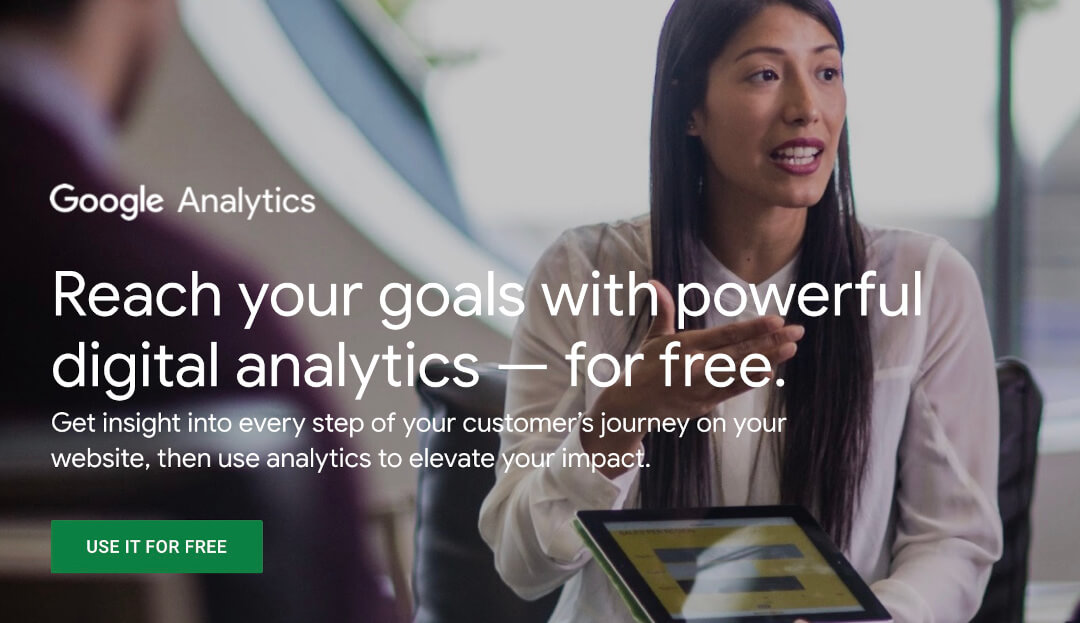
If you're a seasoned marketer, you probably know this next one all too well.
Google Analytics is a free web analytics service offered by Google that tracks and reports website traffic. It is one of the most popular web analytics tools available and is widely used by businesses of all sizes.
Given its superstar status, there are a few reasons why everyone should be using Google Analytics in 2024.
Firstly, Google Analytics provides detailed information about website traffic, including the number of visitors, the pages they visit, and how they interact with the site. This information can be used to identify areas of the website that are performing well and those that need improvement.
Secondly, Google Analytics allows businesses to track conversions, such as form submissions and e-commerce transactions, in one place. This information can be used to measure the effectiveness of different marketing campaigns and optimize the website for conversions.
Thirdly, Google Analytics also provides information about the demographics, interests, and behavior of website visitors, which is critical information when you're trying to determine your buyer personas. This information can be used to segment the audience and create more targeted marketing campaigns across your other channels.
Google Analytics has a wide range of customization options and integrations with other tools, such as Google ads (unsurprisingly), which allows businesses to track the effectiveness of their paid campaigns. This can be helpful in making data-driven decisions and optimizing marketing spend.
Google Analytics also comes with a price tag that will make every marketer happy, as it's completely free to use.
Those who have enterprise-level businesses might want to take a look at Analytics 360 which has more robust features like exporting to BigQuery, but the price tag is around 12-30k per month.
3. Google Data Studio (now Looker Studio)

Google Data Studio (now Looker Studio) is a free data visualization and reporting tool offered by Google. It allows you to connect to various data sources and create interactive and customizable reports and dashboards. There are 21 integrations that are officially built by Looker that include things like Google Sheets and Google Ads/Analytics data, and around 684 partner-created integrations (like Facebook, etc.).
Looker Studio offers a wide range of customization options and pre-built templates, which allows you to create visually appealing and engaging reports and dashboards, but they are solely focused on the Google suite of products.
If you need data from other platforms, you'll need to manually create reports which can be a bit of a pain. There is a free course on how to get the most out of this tool for those who are looking to go that route.
Looker Studio allows you to share and collaborate on reports and dashboards with other team members and share data and insights with stakeholders, as well as have these reports sent out automatically.
Like the other Google products on this list, Looker Studio is technically free to use. However, it's good to mention that if you need to analyze data that lives outside the Google suite of products, you'll either need to invest in connection services like Supermetrics or manually import your marketing channel data to Google Sheets and use that as your data source.
4. Supermetrics
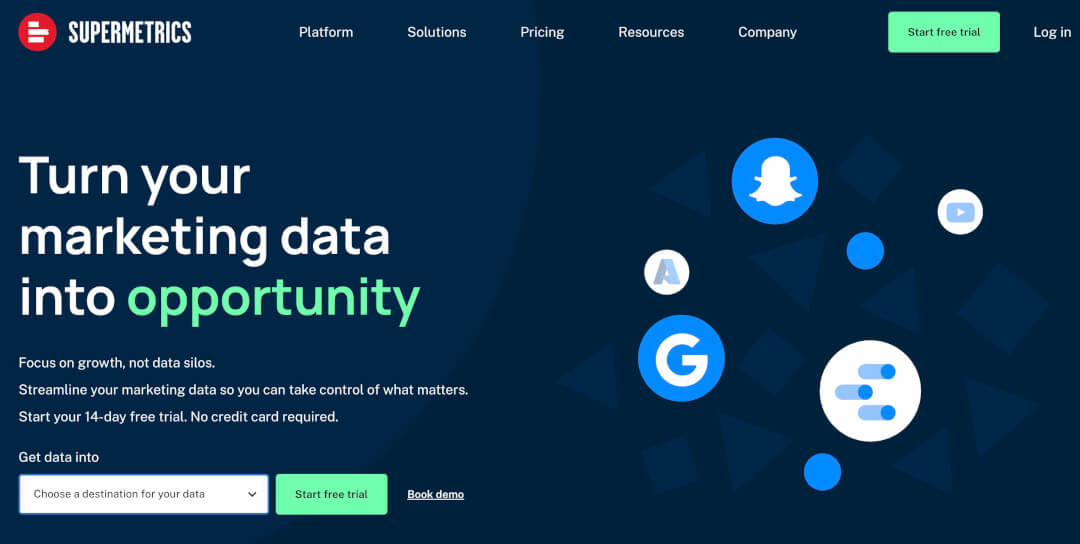
The problem of getting something from one place to another has plagued mankind since the dawn of time—and marketing data is no different.
Supermetrics aims to solve this problem by being the ultimate data warehouse and taxi service between platforms. Supermetrics takes pre-existing data (from 100+ different sources) and syncs that data into popular tools like Google Sheets, Tableau, and Looker Studio.
In this way, Supermetrics doesn't have any dashboard or insights themselves, they simply act as an intermediary to get your data into other places to analyze and report on it later.
They do, however, feature integrations with the endpoint that help to pre-populate your reports with easy-to-use templates. Take their integration with Google Sheets for example:

While it's true that Supermetrics features more integrations than a lot of the others on this list, their pricing ranges from $39-$599 per month for each end destination for Looker Studio, Google Sheets, and Excel. This is aside from their other destinations which require a sales call for pricing.
Depending on what you need and where you need it to go, this can end up being one of the pricier analytics tools on the list.
5. Klipfolio

Next on our list is Klipfolio.
Klipfolio is a cloud-based data analytics and dashboard platform that helps businesses monitor, analyze and act on data that lives inside other sources.
The platform allows users to create and share interactive dashboards, custom reports, and alerts, and connect to a wide variety of data sources including CRMs, paid and organic platforms, and even product analytics tools.
Klipfolio's dashboards are highly customizable and can be tailored to the specific needs of each user, making it easy for them to view and act on the data that is most important to them. Users can also collaborate and share their dashboards and reports with others, enabling teams to work together more effectively.
In addition to its core dashboard and reporting capabilities, Klipfolio also offers a number of advanced features such as data blending, data visualization, and data alerts.
Data blending allows users to combine data from multiple sources into a single view, while data visualization enables users to create charts, graphs, and other visual representations of their data. Data alerts are aptly named, as they notify users when certain conditions are met, such as when a key metric falls below a certain threshold.
Klipfolio is designed to be easy to use, even for those with little or no technical expertise—making it easy for marketing newbies and veterans alike.
Pricing for Klipfolio is a little different from others on the list as they technically offer two different experiences—Klips and PowerMetrics.
Klips is a more traditional marketing analytics tool, offering pre-built dashboards, the ability to export and share reports, etc. PowerMetrics, however, is more for self-serve internal-only team use but allows for deeper optimization of metrics.
For example, those who work within an agency who have traditional metrics and need to share reports internally and externally would be great candidates for Klips.
If you want to create hyper-customized internal metrics and have your own team of data analysts, the personalization that PowerMetrics allows would suit your needs more.
These two products come with their own price point, as you might imagine. Klips starts at $142/month while PowerMetrics starts at $0.
6. Databox
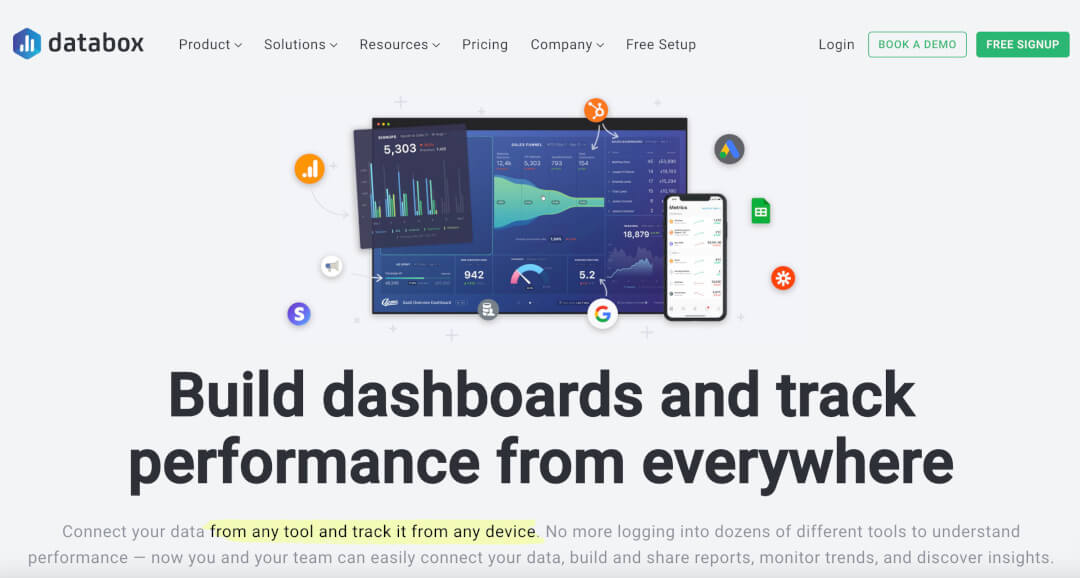
Last on our list is Databox. Like most of the others on this list, Databox's tool allows you to build data dashboards from a variety of other sources and pull them all into one place.
And with 70+ integrations such as Google Analytics, Salesforce, Hubspot, PayPal, and Facebook, you're bound to find the perfect report and integration combination to make your whole marketing team happy.
Databox is a bit different from others on this list as they also offer a mobile app that allows users to access their data on the go, as well as the ability to share reports with clients via email as normal.
Just like the others on the list, Databox offers a variety of pre-built templates and reports that can be easily customized to fit your specific needs. The platform is designed to be simple and intuitive, with a drag-and-drop interface that makes it easy to create custom reports and dashboards.
Databox's pricing is just as flexible as its integration policy. You can get started with a forever-free account which has a limit of 3 data sources and supports 60 integrations.
If you need more than that, you can use a slider on Databox's pricing page to get a real-time quote depending on how many data sources and features you need.
Conclusion
In this post, we've gone over the top 6 marketing analytics tools of 2024 that will help you collect, organize, manage, and analyze data from your marketing channels in one place.
While it may seem like you'll never get out from under the virtual pile of paperwork you manage every day, taking the time to implement and utilize any of the marketing tools we mentioned today will do wonders in reducing your workload, and even allow you to improve your marketing ROI in the process.
Of course, out of all the competition we saw here today, only Madgicx comes with all the data you need in one dashboard, as well as the automation tools you need to optimize your results and skyrocket your business.
With Madgicx's One-Click Report, you can combine multiple ad channels into one fully-customizable report and track your crucial KPIs in real time (net profit, blended ROAS, MER, and more). Try it for FREE!
Tory is a digital marketing specialist and the current Marketing Manager of Breadcrumbs.io. She's been featured in various high-profile marketing blogs like Hootsuite, AdEspresso, and Databox and holds certificates for both Google and Facebook Ads. In her spare time, she gardens and paints from her house in the Florida panhandle.







